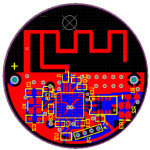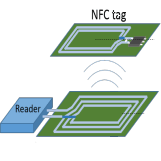分享一个关于天线体积和带宽的讨论
05-08
在一个帖子上看到关于天线体积和带宽的讨论,摘抄其中比较有意思的两个reply
If you imagine an infinitely thin dipole, youcan understand that the electric current really has no degree offreedom there. It has one mode, it must terminate at zero current at theend and for a given frequency, will be sinusoidally distributed along thewire.Now, if you fatten the dipole up, there becomes more freedom,more modes, that can "fit" on the wire. That is, there is more thanone current distributions that satisfies all the universal rulesof maxwell's equations. When you have more freedom or more modes allowedon a wire (as in the case of a fatter dipole), the bandwidthincreases.More modes means more frequencies around the center frequencywill radiate on the structure.
In terms of Q factor explanation for Microstrip antenna:
Bandwidth= resonant freq/ Q factor...
Qsignifies the ratio of Energy stored to energy dissipated..By increasinglarger substrate volume, we are increasing power dissipation.. hence Qdecreases as a whole, and BW increases...
If you imagine an infinitely thin dipole, youcan understand that the electric current really has no degree offreedom there. It has one mode, it must terminate at zero current at theend and for a given frequency, will be sinusoidally distributed along thewire.Now, if you fatten the dipole up, there becomes more freedom,more modes, that can "fit" on the wire. That is, there is more thanone current distributions that satisfies all the universal rulesof maxwell's equations. When you have more freedom or more modes allowedon a wire (as in the case of a fatter dipole), the bandwidthincreases.More modes means more frequencies around the center frequencywill radiate on the structure.
In terms of Q factor explanation for Microstrip antenna:
Bandwidth= resonant freq/ Q factor...
Qsignifies the ratio of Energy stored to energy dissipated..By increasinglarger substrate volume, we are increasing power dissipation.. hence Qdecreases as a whole, and BW increases...
我自己记录下学习心得:所以天线体积,q值和带宽三者之间是有关系的:
天线体积越大—>带宽越大
或者
天线体积越大-> q值变小->带宽越大
但是关于最后一个部分的解释似乎是存在问题的。一个微带天线的Q值由四个部分构成:radiation, surface wave, dielectric 和 conductivity. 在介质很薄的情况下,是radtion 的那部分q值起主要作用,但是radiation的q值和t(介质高度)是成反比的。所以t越大,Q越小。
原文说是因为增加了损耗,应该主要指介质损耗,这个说法我觉得欠妥。因为在实际仿真的时候,我们可以假设介质无耗,但是相信增加介质高度也可以同样增加带宽的。
以上是个人愚见,请牛人指正
文献出处呢?麻烦给出
这个没有什么文献出处的,是我在别的论坛上看到的一段讨论,我觉得挺有意思的,就转过来了。
相关文章:
- 天线基本知识及应用--天线的分类与选择(05-08)
- 关于同轴天线(05-08)
- 广播收听中关于天线的一些基本概念(05-08)
- 智能天线及其应用(05-08)
- 探索智能天线技术(05-08)
- 浅谈智能天线技术(05-08)
天线设计培训教程推荐








